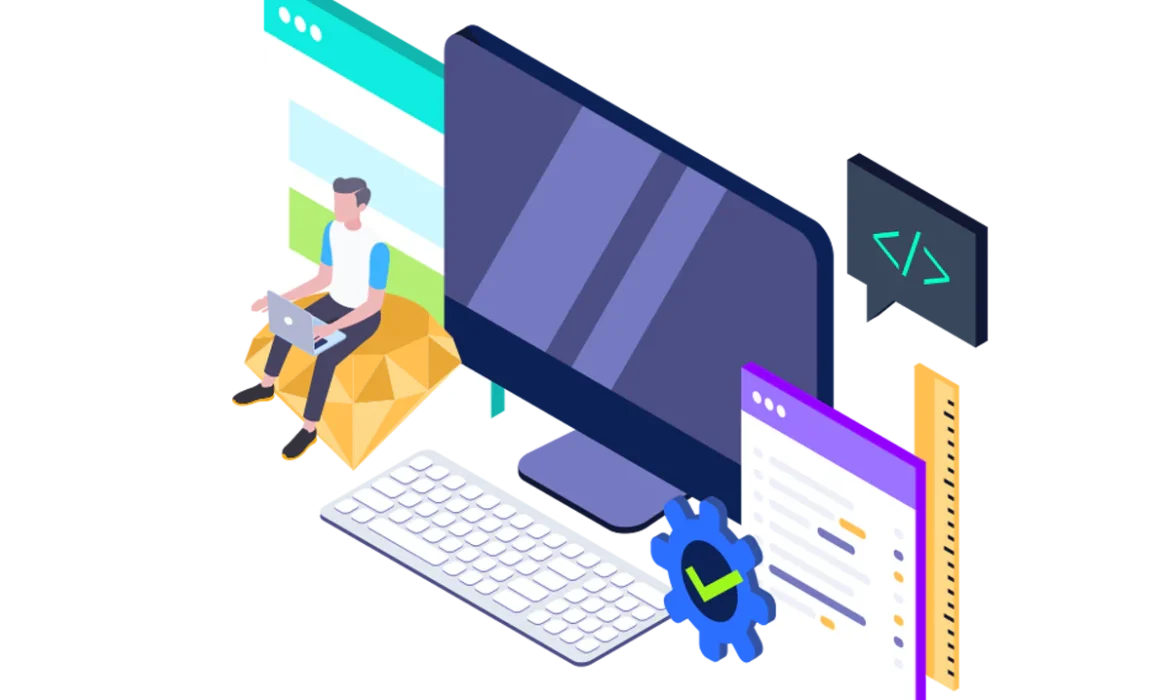Nutzung von Cloud-Plattformen für die Webentwicklung: AWS, Azure und GCP
Einführung
Im dynamischen Bereich der Webentwicklung the need for scalable, flexible, and cost-efficient solutions has never been greater. Traditional on-premises infrastructure often struggles to meet the demands of modern web applications, leading to limitations in scalability, high upfront costs, and complex maintenance challenges. To address these limitations, cloud platforms have emerged as game-changers, providing a plethora of services and resources that empower web developers to build, deploy, and manage web applications with unprecedented ease and efficiency.
The Cloud Computing Paradigm: A Transformation for Web Development
Cloud computing offers a service-based delivery model, where computing resources, such as servers, storage, databases, and networking, are provided over the internet. This eliminates the need for organizations to invest in and maintain their own physical infrastructure, significantly reducing upfront costs and simplifying IT management. Cloud platforms like AWS (Amazon Web Services), Azure (Microsoft Azure), and GCP (Google Cloud Platform) have become the leading providers of cloud computing services, offering a comprehensive suite of tools and resources tailored for web development.
Benefits of Leveraging Cloud Platforms for Web Development
Skalierbarkeit: Cloud platforms provide on-demand scalability, allowing you to easily scale your infrastructure up or down based on changing traffic demands, ensuring optimal performance and cost-efficiency.
Flexibility: Cloud platforms offer a wide range of services, enabling you to choose the right tools and technologies for your specific needs, whether it’s building web applications, deploying databases, or implementing machine learning solutions.
Cost-Efficiency: Cloud platforms operate on a pay-as-you-go model, eliminating upfront infrastructure costs and allowing you to optimize expenses based on your actual usage.
Globale Reichweite: Cloud platforms provide a global infrastructure, enabling you to deploy your web applications closer to your users, reducing latency and improving performance worldwide.
Reliability: Cloud platforms offer robust and redundant infrastructure, ensuring high availability and disaster recovery capabilities for your web applications.
Innovation: Cloud platforms are constantly evolving, providing access to cutting-edge technologies and services, such as serverless computing, containerization, and microservices architecture.
Exploring the Cloud Service Landscape: IaaS, PaaS, and SaaS
Cloud platforms offer a variety of service models to cater to different development needs:
Infrastructure as a Service (IaaS): IaaS provides virtualized infrastructure resources, such as servers, storage, and networking, allowing you to have full control over your infrastructure environment.
Platform as a Service (PaaS): PaaS provides a platform for developing, deploying, and managing web applications, abstracting away the underlying infrastructure complexity.
Software as a Service (SaaS): SaaS offers ready-to-use applications delivered over the internet, eliminating the need for installation, maintenance, and upgrades.
Choosing the Right Cloud Platform: AWS, Azure, or GCP
Each cloud platform has its strengths and considerations:
AWS: AWS is the most mature and widely adopted cloud platform, offering a comprehensive suite of services and a vast global infrastructure.
Azure: Azure is a strong choice for businesses already using Microsoft technologies, offering seamless integration with Microsoft products and services.
GCP: GCP is known for its innovation and competitive pricing, particularly attractive for startups and data-driven applications.
Abschluss
Cloud platforms have revolutionized web development, providing a powerful foundation for building, deploying, and managing scalable, flexible, and cost-efficient web applications. By embracing cloud technologies like AWS, Azure, and GCP, web developers can unlock a world of possibilities, accelerating development cycles, enhancing collaboration, and delivering exceptional user experiences that meet the ever-evolving demands of the digital world.
Call to Action
Ready to embark on your cloud journey and transform your web development process?
DevOps-Praktiken für die Webentwicklung: Optimierung von Entwicklung und Bereitstellung
Einführung
Im dynamischen Bereich der Webentwicklung the need for rapid innovation, seamless deployment, and reliable software delivery has never been greater. Traditional development methodologies often struggle to keep pace with these demands, leading to bottlenecks, delays, and a disconnect between development and operations teams. To address these challenges, DevOps has emerged as a transformative approach, bridging the gap between development and operations, and streamlining the entire software delivery lifecycle.
The DevOps Revolution: Transforming Web Development
DevOps is a set of practices and philosophies that aim to unify software development and IT operations. It emphasizes collaboration, automation, and continuous delivery, enabling organizations to release high-quality software more frequently and reliably. By adopting DevOps practices, web developers can:
Reduce Development Time: Automate repetitive tasks, streamline workflows, and eliminate bottlenecks, leading to faster development cycles.
Improve Deployment Speed: Implement continuous integration and continuous delivery (CI/CD) pipelines to automate testing and deployment, enabling rapid and reliable software releases.
Enhance Collaboration: Foster a culture of collaboration between development and operations teams, breaking down silos and aligning goals.
Increase Reliability: Implement infrastructure as code (IaC) to provision and manage infrastructure consistently and reliably.
Improve Monitoring and Logging: Continuously monitor applications and infrastructure to identify and resolve issues proactively.
Essential DevOps Practices for Web Developers
Adopt a DevOps Culture: Encourage collaboration, communication, and shared responsibility between development and operations teams.
Automate Everything: Automate repetitive tasks, such as testing, deployment, and infrastructure provisioning, using tools like Jenkins, GitLab CI/CD, or Ansible.
Implement Continuous Integration (CI): Integrate code changes frequently, running automated tests to ensure quality and prevent regressions.
Embrace Continuous Delivery (CD): Automate deployment pipelines, releasing new versions of software seamlessly and reliably.
Leverage Infrastructure as Code (IaC): Define infrastructure using code, such as Terraform or CloudFormation, ensuring consistent and reproducible environments.
Utilize Containerization: Package applications and their dependencies into containers, using Docker or Kubernetes, for portability and isolation.
Adopt Cloud Deployment: Leverage cloud platforms like AWS, Azure, or GCP for scalability, flexibility, and cost-effectiveness.
Practice Continuous Monitoring: Continuously monitor application performance, infrastructure health, and user behavior to identify and address issues promptly.
Implement Effective Logging: Log application events, infrastructure changes, and user interactions to gain insights and troubleshoot problems efficiently.
Abschluss
DevOps has revolutionized web development, providing a powerful approach to building, deploying, and managing modern web applications. By embracing DevOps practices, web developers can streamline their processes, enhance collaboration, and deliver high-quality software with unmatched speed, reliability, and efficiency. As the demand for agile, scalable, and secure web applications continues to grow, DevOps is poised to play an increasingly pivotal role in the future of web development.
Call to Action
Ready to transform your web development process with DevOps?
Our team of experienced DevOps engineers and web development specialists can help you implement DevOps practices effectively, enabling you to streamline your development workflows, accelerate deployment cycles, and build a culture of collaboration and continuous improvement. We’ll work closely with you to assess your current development processes, Bereiche mit Verbesserungspotenzial identifizieren, and implement the right DevOps tools and practices to meet your specific needs and goals. Together, we can transform your web development process and deliver exceptional software that meets the demands of today’s dynamic business landscape.
Building Microservices Architectures for Scalable and Resilient Applications
Einführung
In the dynamic realm of software development, the need for scalable and resilient applications has never been greater. Monolithic architectures, once the norm, are struggling to keep pace with the demands of modern applications, often leading to bottlenecks, performance issues, and challenges in maintaining and evolving codebases. To address these limitations, microservices architecture has emerged as a powerful and popular approach, offering a paradigm shift in how software is designed, developed, and deployed.
Demystifying Microservices Architecture
Microservices architecture is a software development style that structures an application as a collection of small, independent, and loosely coupled services. Each service is responsible for a specific functionality and communicates with other services through well-defined interfaces, such as APIs. This modular approach offers a multitude of benefits, including:
Skalierbarkeit: Microservices can be scaled independently, allowing developers to allocate resources efficiently based on varying workloads and traffic patterns.
Resilience: If one microservice fails, the overall application remains functional, as other services can continue operating without interruption.
Agility: Microservices enable faster development cycles, easier deployment, and simplified maintenance, fostering a more agile development process.
Technology Heterogeneity: Microservices can be built using different programming languages, frameworks, and databases, promoting flexibility and choice.
Fault Isolation: Failures are contained within individual services, preventing them from cascading and affecting the entire application.
Essential Principles for Building Microservices Architectures
Service Autonomy: Each microservice should be independent, self-contained, and responsible for a well-defined business capability.
Loose Coupling: Services should communicate through lightweight interfaces, such as APIs, minimizing interdependencies and promoting flexibility.
Service Discovery: Mechanisms should be in place for services to dynamically discover and connect with each other.
Load Balancing: Traffic should be distributed evenly across multiple instances of a service to prevent overloading and ensure optimal performance.
Fault Tolerance: Services should be designed to handle failures gracefully, isolating issues and preventing them from disrupting the overall application.
API Gateways: An API gateway should act as a single entry point for clients, providing security, routing, and aggregation of microservice APIs.
Containerization: Containerization technologies like Docker can be used to package and deploy microservices, ensuring consistent environments and simplifying deployment.
DevOps: DevOps practices should be adopted to streamline development, testing, and deployment processes, enabling continuous delivery of microservices.
Realizing the Benefits of Microservices Architecture
Improved Scalability: Microservices can handle increasing workloads and traffic demands without compromising performance.
Enhanced Resilience: Applications built with microservices are more resistant to failures and can recover quickly from disruptions.
Accelerated Development: Microservices promote faster development cycles and easier deployment, enabling rapid innovation.
Simplified Maintenance: Microservices are easier to maintain, update, and evolve due to their modular and independent nature.
Reduced Development Costs: Microservices can lead to lower development costs due to their flexibility, agility, and reduced need for monolithic infrastructure.
Abschluss
Microservices architecture has revolutionized the way software applications are designed, developed, and deployed. By embracing microservices principles and implementing effective practices, developers can create scalable, resilient, and agile applications that can meet the ever-evolving demands of modern software landscapes. As the demand for high-performance, reliable, and adaptable applications continues to grow, microservices architecture is poised to play an increasingly pivotal role in the future of software development.
Call to Action
Ready to embark on your microservices journey and build scalable, resilient, and future-proof applications?
Our team of experienced software architects and developers can guide you through the intricacies of microservices architecture, helping you design, develop, and deploy microservices-based applications that are tailored to your specific needs and requirements.








